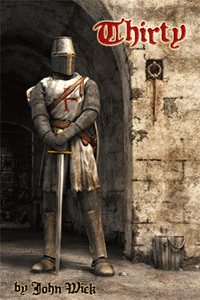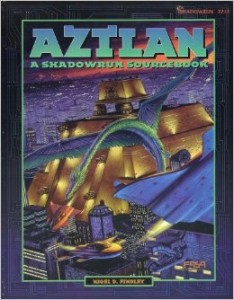Weirdest RPG owned is today, last year’s #RPGaDay topic.
Okay then, let’s talk John Wick’s Thirty.
Note: I’m going to spoil the ending to that game. Stop reading and experience the magic firsthand.
 I’ve never really picked up any of John’s big games: 7th Sea, Legend of the Five Rings, or even Houses of the Blooded. Everything I have of Wick’s has been his little games. Thirty is the closest thing to one of his big games, but it’s not. It says so in the name, which truthfully is Thirty: A Little Game about a Big Secret.
I’ve never really picked up any of John’s big games: 7th Sea, Legend of the Five Rings, or even Houses of the Blooded. Everything I have of Wick’s has been his little games. Thirty is the closest thing to one of his big games, but it’s not. It says so in the name, which truthfully is Thirty: A Little Game about a Big Secret.
It’s also not one of his little games, either. This is a full on campaign that’s guided from point A to point B all the way to point L. No deviations, sir.
And you can’t play it over the internet. You have to play it at someone’s house at a table where you can look each other in the eye and hear each other breathe.
This is a game about the Knights Templar and what happened to them and the treasure they guarded. You play Knights, right on the eve of the destruction of the order. The Inquisition comes for you and the hidden treasure of the Knights Templar, but when they arrived, thirty knights were missing. That’s who you are: the thirty Templar Knights, carrying a secret treasure. And that’s all you know when you sit down to play.
What then, do you think the game is about? Knights, in disguise, forced to hide within 14th Century Europe, safeguarding a treasure or secret from those who would wrest it away from them? Something like that. Whatever the specifics, it’s pretty obvious you’re playing the guardians of a secret treasure and trying to keep it safe from some villains (and possibly prove to the world that the Knights Templar are the good guys).
That’s obvious.
You’re wrong.
You’re the last thirty Knights, that’s true. You’re the guardians of the secret treasure of the order, that’s true. But the campaign starts with you, on horseback, riding out of the main Templar stronghold towards Heaven to confront God.
They encounter a battlefield where a fight has begun an eternity ago and continues forever. They encounter Wotan on the tree. They pass through The Forest. There’s a passage through the Underworld. There’s a passage through Santa Monica Boulevard, which is equally perilous. There is more and more, and it’s all from John Wick, written about the time he joined the Freemasons, and it’s full of occultism and belief systems and religion and Religion and at the end the remaining Knights of the original Thirty come face to face with God.
Do you want to know what happens when they meet God? Do you?
I will tell you.
But you should stop reading now.
You really should. It’s the closest thing to real magic you may ever experience and I’m going to ruin it for you.
I’m writing these few lines to give you enough time to turn back, turn away, just as the Knights should have.
This is how they meet God.
This is why Thirty is the weirdest RPG I own.
You were warned.
The Knights awaken with the moon overhead, sitting on a dirt road in the woods. A paved driveway winds through the trees, past a low stone well, and up towards a pale yellow house. Lights are on inside. The Knights are still in their knightly garb. Their companion shakes their hands, tips his top hat, and steps back saying, “I do not envy what you are about to learn… but… I do envy the power it will give you.†He points to the front door. “Go there. Knock. Then wait.â€
The players at the table have their characters walk up the driveway. They climb the steps. And as the players tell you they are knocking at the door – there is knocking at your front door.
Behind the magic: You have an accomplice that is outside, with a cell phone. You call them as the Knights arrive to meet God. They listen to the players. When the players say their Knights knock at the door, you know what happens.
From the book: “Your players will probably jump. If even for a moment – if even for a moment – the lizard part of their brain makes the connection: holy shit… ourcharacters just knocked on the door!  – if they make this connection even for a moment, you’ve accomplished something no book, TV show, or movie can accomplish. For that moment, your players will be stuck, as Neil Peart put it, between Sun and Moon. The space between wonder and why. That place we were in when we were kids, listening to the story of a haunted house while sitting in the very room where that murder took place. Sitting out in the woods, listening to the story of The Hook…. If you do it right, your players will be talking about it for years. Good luck.â€
The game continues. The Knights enter your house. They Knights meet their creators.
And then they continue their journey.

 Maybe it’s not that. Maybe it’s which publisher publishes your favorite stuff? Or which one made your favorite game? Or which one has a constant output of new stuff, continually making your game better and better?
Maybe it’s not that. Maybe it’s which publisher publishes your favorite stuff? Or which one made your favorite game? Or which one has a constant output of new stuff, continually making your game better and better? Now, I love me some Shadowrun and I’ve always liked their books because they incorporated game fiction in a way that wasn’t just two to six pages of short stories. Most sourcebooks featured in-game information that was player-friendly, presented as files uploaded to a website, followed by a game rules section that showed how to use all that stuff in your game. The first section was full of ShadowTalk, comments on the actual datafiles you were reading, by other characters in the game world. There would be arguments, tangential discussions, and corrections of “facts†in the “real†datafile. There were recurring characters showing up in the sourcebooks, all with their own unique voices, style, and perspective on the articles mentioned. It actually made the game world feel larger.
Now, I love me some Shadowrun and I’ve always liked their books because they incorporated game fiction in a way that wasn’t just two to six pages of short stories. Most sourcebooks featured in-game information that was player-friendly, presented as files uploaded to a website, followed by a game rules section that showed how to use all that stuff in your game. The first section was full of ShadowTalk, comments on the actual datafiles you were reading, by other characters in the game world. There would be arguments, tangential discussions, and corrections of “facts†in the “real†datafile. There were recurring characters showing up in the sourcebooks, all with their own unique voices, style, and perspective on the articles mentioned. It actually made the game world feel larger.